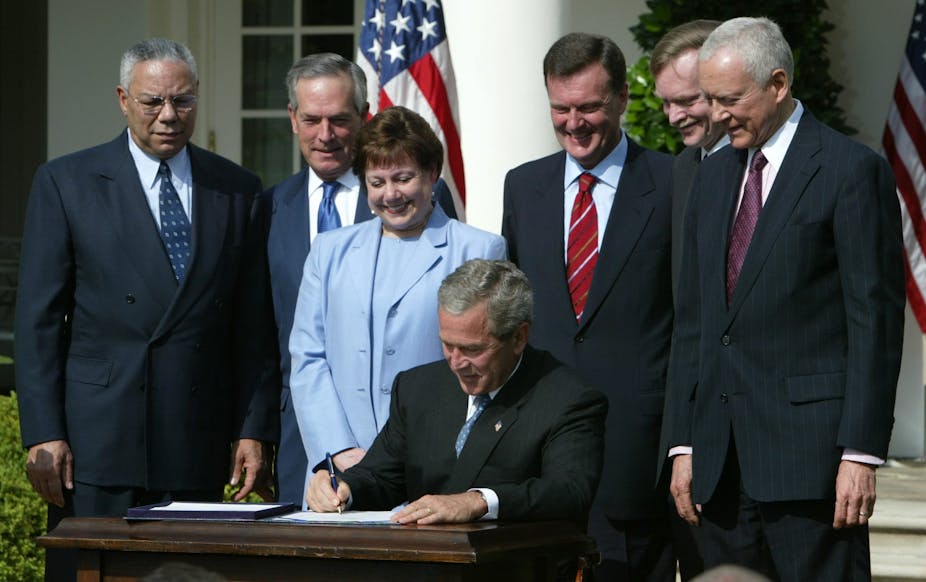Ten years on from the Australia-US Free Trade Agreement, Australia is entering another round of negotiations towards the new and controversial Trans-Pacific Partnership. In this Free Trade Scorecard series, we review Australian trade policy over the years and where we stand today on the brink of a number of significant new trade deals.
Almost ten years on from ratifying the Australia-United States Free Trade Agreement (AUSFTA), the level of concern it generated among academics, NGOs and others has heightened in response to further FTA and plurilateral negotiations. Similar obligations, and more, are being pushed through the Trans-Pacific Partnership (TPP).
The AUSFTA was a watershed event. A broad range of federal and state bureaucracies had to engage in highly complex negotiations. As the Senate Select Committee 2004 report lamented, particularly in relation to intellectual property rights, the evidence received showed few policy experts were sufficiently prepared, resourced or intellectually attuned for these complex and lopsided negotiations.
No consensus emerged in the Senate report to help define Australia’s national interest. This high-level forum could have served to formally clarify ambiguities or register interpretations of the text. In contrast, the US recorded its interpretation of AUSFTA language before it passed through Congress.

Missing this important opportunity, the Senate committee’s deputy chair, George Brandis, concentrated on defending the treaty text. Opposition parties, although often lacking critical information, utilised the submissions and evidence to provide a critique which remains highly relevant.
The commitments are complex, policy-limiting and legally enforceable. Many obligations were spelt out in detail, some went unrecognised and others were not interpreted adequately for their budgetary and policy consequences, then or now.
At one level the negotiators can be seen to have delivered this politically driven task within an amazingly short timeframe. But at what cost and how well-briefed were their ministers on the consequences?
A key failing identified in the Senate report was the lack of policy coherence to understand consequences across the spectrum of Australia’s economic, social and development sectors. So has this situation improved?
In Australia’s national interest?
It could be claimed that ten years on negotiators are more capable of preserving Australia’s key interests. But the NGO, academic, consumer and public policy experts who follow this process generally do not agree.
The TPP briefings and the leaked text of the proposed agreement provide some insights into positions taken by Australia. For these TPP negotiators, the AUSFTA appears as the unquestioned starting point. Even the evidence provided by the original AUSFTA negotiators, claiming flexibility to pursue Australia’s national interest in several policy areas, has been forgotten or ignored. Or, more problematically, particularly for policy coherence, it has not been understood.
The lessons that should have been drawn from the Senate report have been largely ignored. So perhaps it is time to go back to first principles to see just what the negotiators claimed they agreed.
Evidence given shows these public servants defended many positions as being open for Australia to implement in its national interest. There is little evidence that this is how the AUSFTA is being implemented.
Are AUSFTA obligations understood?
Given the legal complexity of the esoteric text, lack of public engagement should not be read as tacit support. But it would be interesting to know how many of those who actively promote greater FTA engagement actually understand the AUSFTA.
Have they read it? Have they paid lawyers to give them an assessment of its meaning? Or is it only particular segments that have been scrutinised to take advantage of the expansive provisions? The intellectual property chapter, for instance, is an 11,500-word gift for the IP legal industry to interpret generously.
The AUSFTA embeds commitments that go well into the future, with the capacity to prevent elected governments acting on behalf of citizens in important areas of health and social policy.
Provisions such as national treatment, standstill arrangements and 20-year copyright extension have significant consequences. Would Australians approve dispute or consultative provisions that can facilitate US-based corporations accessing Australia’s bureaucracies and influencing what is acceptable?
That means negotiating with our public servants, scientific, quarantine and regulatory experts on issues such as setting standards, labelling, technical and conformity regulations and decisions on pharmaceuticals. That sort of access diminishes Australia’s sovereignty.
These treaty obligations have a very large public policy footprint in the economy and consequences for social and health policy options and budgets. So much more attention is required to ensure a fuller comprehension of what these obligations entail before we expand their application.
‘Behind the Border’ – or how to give away sovereignty
This interesting term defines the obligations mentioned above. The Senate took evidence highlighting the reciprocal obligations flowing from Article 8.7. Australia must allow the US to participate in the development of standards and technical regulations:
… on terms no less favourable than those accorded to [Australia’s] own persons.
TPP proposals go even further. These set in place specific regulations for cosmetics, medical devices and other pharmaceutical products.
Both parties are subject to these treaty provisions, but few Australian companies would be capable of taking the US to task. Also, it opens opportunities - like the use of investor-state dispute settlement (ISDS) procedures in the tobacco plain packaging case - for global corporations to cherry-pick specific elements of countries’ trade obligations. Pertinent examples could involve blocking labelling or standards associated with policies to tackle obesity or diabetes, or information on use of antibiotics in cattle or fish.

Article 8 provisions can have real consequences. The Australian Department of Health decision not to allow labelling of cosmetics containing nanoparticles fits into Article 8 obligations. This decision seems dubious when even Australia’s peak cosmetics body, ACCESS, argued strongly for this information to be on its products.
The European Union has mandated nanoparticle information be available to consumers. Without this labelling, Australian cosmetics will not be able to enter the EU market.
Consumers support receiving such information. The science on nanoparticles is not settled and the cosmetics industry is one of the main areas for expanding this technology.
So why did health authorities not support nanolabelling? One can only guess at how this policy decision was taken, but consumers deserve to know.
There are several possible scenarios. Was there an exchange of views under Article 8.7? Or was the decision influenced in anticipation that the US would challenge such labelling? US cosmetic corporations may have lobbied well enough in Canberra to rule out any thought of providing consumer information on nanoparticles.
Or it may be none of the above. But transparency is essential to maintain confidence in sensitive public policy decisions.
Trade negotiations 101!
This article provides a comprehensive assessment of anticipated TPP text that goes well beyond obligations provided for in AUSFTA. To go down this road only further limits Australia’s opportunities for innovation and development.
The article references the Pharmaceutical Patents Review, highlighting losses to Australia of billions of dollars of export revenue, blocked by IP provisions. The AUSFTA further damaged this export opportunity through imposing “standstill” provisions.
A US generic drug company was blocked from establishing a strategically important export industry by an untested interpretation of IP. The US company left frustrated, establishing instead its generic production in India.
The patents review questions Australia’s lack of strategy and passive approach in IP negotiations and “insufficient attention paid to domestic IP interests”. Also criticised is the failure to use AUSFTA negotiations to resolve the generic export issue or trade it off against higher IP provisions given to the US.
This article draws on research prepared for the 2014 Workshop “Ten Years since the Australia-US Free Trade Agreement: Where to for Australia’s Trade Policy?”, sponsored by the Academy of the Social Sciences in Australia and Faculty of Arts and Social Sciences, UNSW Australia.

